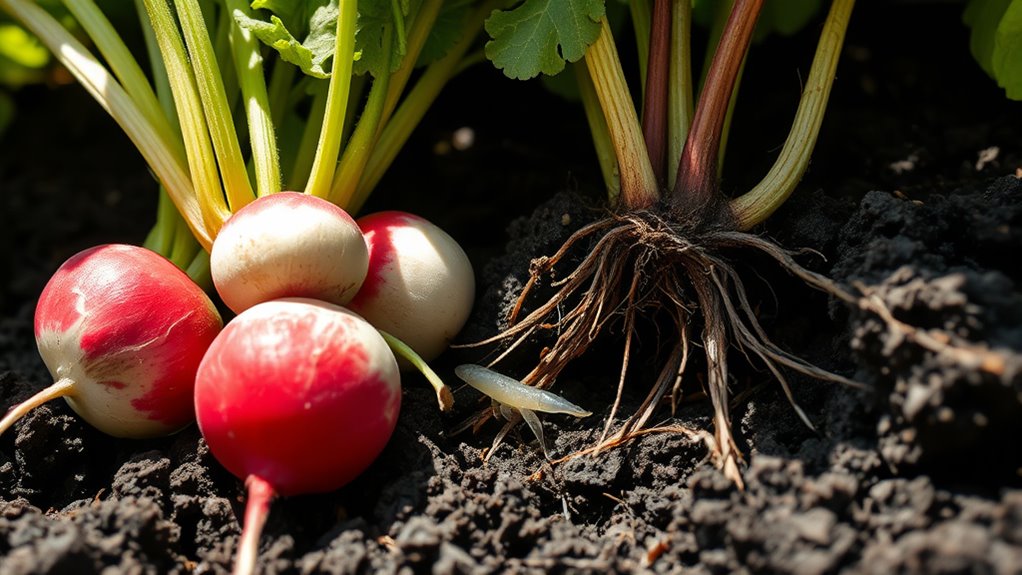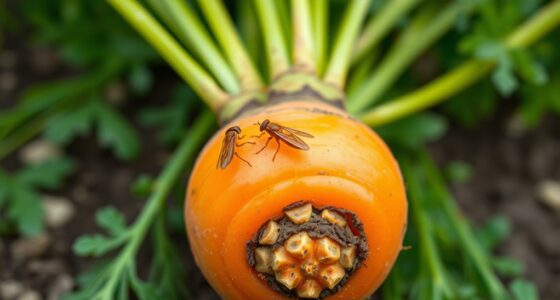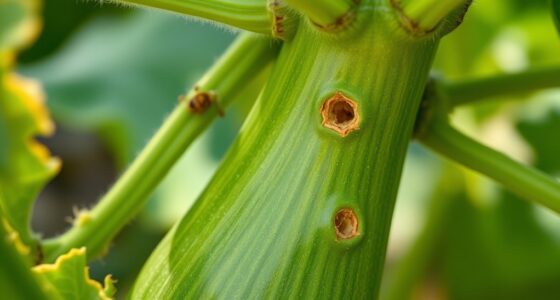To spot root maggots in your radishes, look for wilting, soft roots, holes, or tunnels near the base. Gently inspect the roots for tiny larvae or dark, mushy patches. Managing soil conditions is key—rotate crops, avoid planting in the same spot, and maintain proper pH levels. Using beneficial nematodes or organic controls can help reduce infestations. Continue exploring to learn how soil management and eco-friendly practices can protect your garden from these pests.
Key Takeaways
- Look for wilting, frayed roots, and small tunnels near the root base as early signs of root maggot infestation.
- Detect soft, foul-smelling, or discolored radishes, and gently inspect for larvae or tunnels inside the roots.
- Maintain soil pH between 6.0-7.0 and practice crop rotation to deter root maggot development.
- Use beneficial nematodes, organic insecticides like spinosad, and encourage natural predators to control soil pests.
- Regular soil testing and proper organic amendments help improve soil health and reduce suitable conditions for maggot breeding.
Recognizing the Early Signs of Root Maggots in Radishes

Recognizing the early signs of root maggots in radishes is essential for effective pest management. You should pay close attention to the appearance of your radishes, especially if you notice abnormal wilting or stunted growth. Keep an eye out for small holes or tunnels near the root base, which indicate early insect activity. Implementing companion planting with plants like marigolds or onions can help deter pests naturally. Mulch techniques also play a vital role; applying a layer of organic mulch can suppress weed growth and create a barrier that makes it harder for maggots to reach the roots. Regular inspection of your radish beds allows you to catch problems early, giving you a better chance to prevent severe infestations before they cause significant damage. Additionally, understanding the role of soil conditions can help you modify your gardening practices to make the environment less hospitable for root maggots.
Typical Damage Patterns Caused by Root Maggots
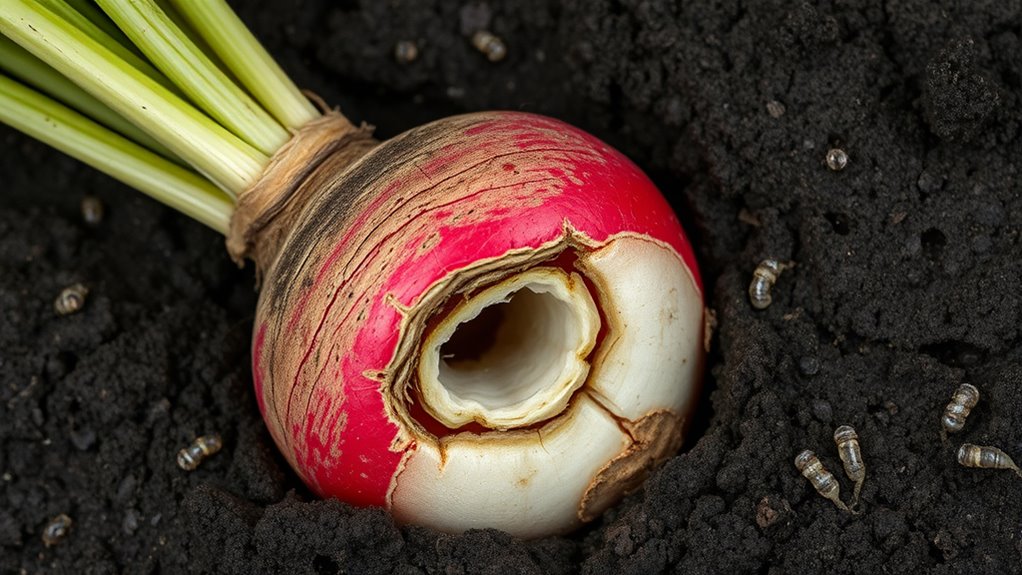
Root maggots cause distinctive damage patterns that can quickly compromise your radishes’ health. You might notice gnawed or frayed roots, often with ragged holes or tunnels running through them. These injuries weaken the plant, making it susceptible to disease and rot. You could also see stunted growth and misshapen roots, which are clear signs of maggot activity. To prevent these issues, consider using companion planting with herbs like mint or marigolds, which can deter pests. Choosing pest resistant varieties of radishes can also reduce damage. Additionally, understanding appliance integration features can help maintain a healthy soil environment by managing watering and soil conditions effectively. Keep an eye out for these damage patterns to catch infestations early and implement effective soil solutions, ensuring healthy, thriving radish crops.
How to Inspect Soil for Root Maggot Presence
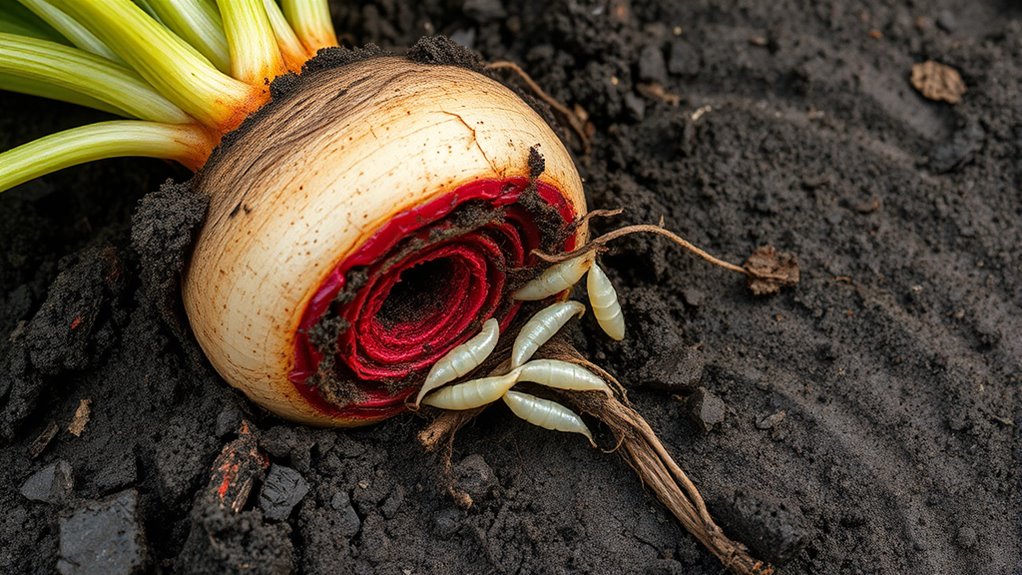
To effectively manage root maggot problems, regularly inspecting your soil is essential. Begin with soil testing to assess conditions that attract pests, like high organic matter or moisture levels. Soil testing can reveal nutrient imbalances or excess organic material that supports maggot development. Incorporate pest monitoring by inspecting soil surfaces and root zones for signs of larvae or adult flies. Use a garden fork or trowel to gently lift soil and check for hidden pests. Look for small holes, chewed roots, or maggot larvae. Consistent monitoring helps you catch infestations early before they damage your radishes. Keep records of your inspections to identify patterns or recurring issues, enabling you to adopt targeted soil management practices for effective root maggot control. Additionally, understanding the effectiveness of eye patches can help in managing stress or fatigue during intensive gardening periods.
Identifying Maggot Infestation in Radish Roots
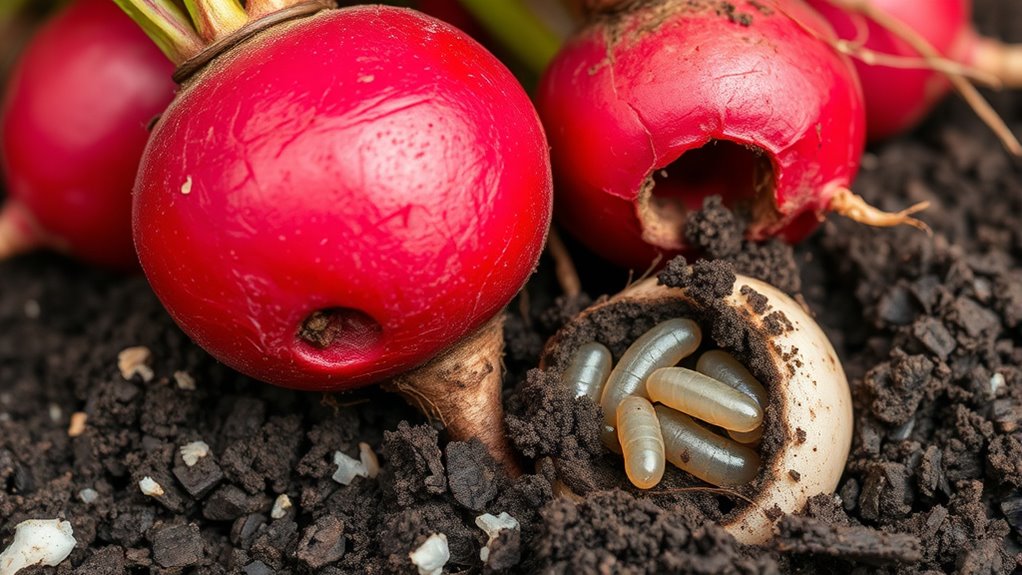
You can spot maggot infestation by looking for visible worms or holes in your radishes. Damaged roots often feel soft or mushy and may emit a foul smell. Pay close attention to changes in texture and odor to catch early signs of maggot activity. Using soil health practices can help prevent maggot infestations in your radish crops.
Visible Maggot Presence
Maggot infestation in radishes often becomes apparent through visible signs inside the roots. You might notice small tunnels or holes, which indicate maggots feeding within. Sometimes, you’ll see soft, rotting spots where the maggots have caused decay. The presence of maggots also signals ongoing issues with the maggot lifecycle, as these pests develop rapidly inside contaminated soil. Soil contamination from previous infestations can harbor maggots or eggs, making it easier for new generations to invade your radishes. To identify infestation early, look for:
- Tiny, white larvae moving inside the radish
- Discolored or shriveled root areas
- Foul smell emanating from the soil or roots
- Soil contamination from previous infestations can make your radishes more susceptible to maggots, emphasizing the importance of proper soil management.
Being vigilant helps you catch the problem before it worsens and spreads further.
Radish Root Damage
Radish root damage caused by maggots is often evident through specific signs on the roots themselves. You might notice hollowed-out areas or tunnels running through the radish, indicating internal decay. The affected roots tend to be less firm and may feel spongy or soft when you handle them. This damage can also alter the radish’s flavor, making it bitter or off-putting compared to healthy roots. If you see irregular holes or softened spots, it’s a clear sign that maggots have infested your radishes. These signs usually appear before any visible maggots, so inspecting roots closely during harvest helps prevent harvesting heavily damaged produce. Recognizing these damage signs early allows you to take action and protect future crops from maggot infestations. Proper soil management and crop rotation also play a role in reducing the likelihood of maggot infestations in your radishes.
Smell and Texture
Detecting maggot infestation in radish roots often involves paying close attention to their smell and texture. You might notice smell changes, such as a foul or sour odor, indicating decay caused by maggots. Texture modifications are also key—roots may feel soft, spongy, or slimy instead of firm and crisp. These signs suggest internal damage and possible maggot presence. To confirm, gently cut into the radish; look for small grubs or tunnels. Keep an eye out for:
- Unpleasant, off-putting odors
- Soft, mushy, or slimy spots
- Visible tunnels or frass inside the root
Recognizing these signs early helps prevent spreading and ensures you remove affected radishes promptly.
The Life Cycle of Root Maggots and Their Impact on Crops

Understanding the life cycle of root maggots is essential for managing their impact on crops. These pests start as eggs laid in the soil, hatch into maggots that feed on radish roots, causing damage and stunted growth. Their maggot biology enables rapid reproduction, leading to severe infestations. Soil contamination with these larvae spreads quickly, making early detection vital. Knowing their cycle helps you intervene at the right moment, reducing crop loss. Here’s a quick overview:
| Stage | Impact |
|---|---|
| Egg | Laid in soil, ready to hatch |
| Larva (Maggot) | Feeds on roots, causes decay |
| Pupa | Develops in soil, prepares to emerge |
| Adult Fly | Continues cycle, spreads soil contamination |
A thorough understanding of soil health can aid in preventing infestations by promoting beneficial microbial activity that deters maggot development.
Soil Management Practices to Prevent Root Maggot Infestations

Effective soil management is key to preventing root maggot infestations in your crops. You should focus on maintaining healthy soil conditions through practices like cover cropping, which offers benefits such as reducing pest populations and improving soil structure. Incorporate cover crops like clover or rye to suppress weed growth and attract beneficial insects. Managing soil pH is equally important; aim for a slightly acidic to neutral pH (6.0-7.0), as extreme pH levels can attract pests. Regularly test your soil to monitor pH and nutrient levels. Additionally, avoid over-fertilization, which can encourage maggot activity. Proper sanitation, such as removing crop residues, also helps reduce breeding sites for pests. These practices create a less hospitable environment for root maggots, protecting your radishes naturally. Implementing vertical storage solutions and organizing your garden tools can also help maintain a tidy space, reducing potential hiding spots for pests.
Crop Rotation Strategies to Reduce Soil-Borne Pests

Implementing crop rotation is a proven strategy to reduce soil-borne pests like root maggots. By rotating radishes with non-host crops, you interrupt their life cycle. Focus on cover crop selection; legumes like clover or vetch improve soil health and break pest cycles. Incorporate composting techniques by adding composted organic matter to the soil, which enhances beneficial microbes that suppress pests. Avoid planting radishes in the same spot for at least two seasons. Instead, choose crops unrelated to root maggot hosts, such as beans or leafy greens. This rotation reduces pest populations naturally and improves soil fertility. Incorporating soil health practices can further enhance the soil’s resilience against pests. Combining thoughtful cover crop choices with effective composting creates an inhospitable environment for pests, protecting your radishes and boosting overall crop health.
Organic and Chemical Soil Treatments for Root Maggot Control
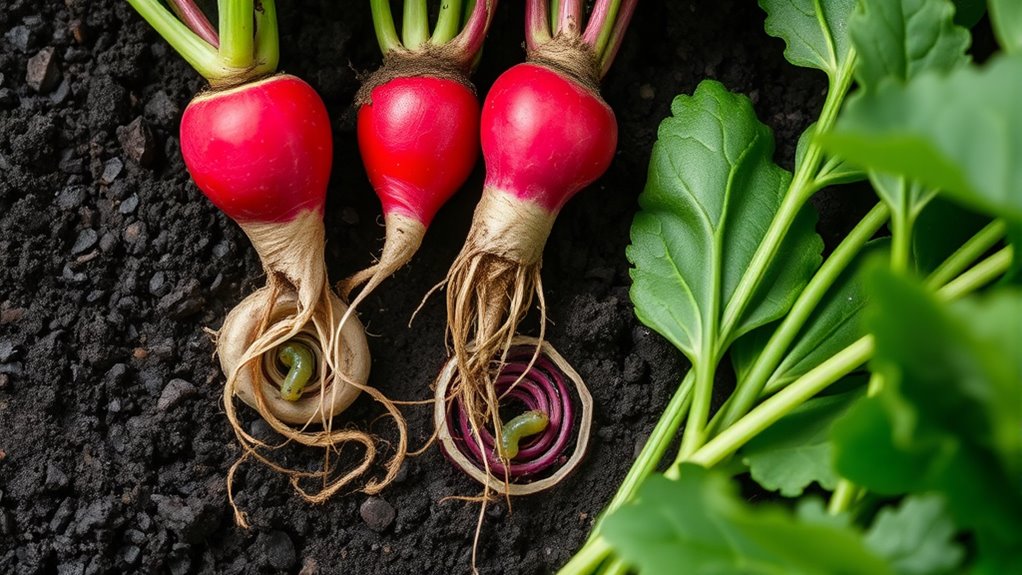
To further protect your radishes from root maggot damage, applying organic and chemical soil treatments can be highly effective. Organic options include beneficial nematodes that target maggot larvae and organic insecticides like spinosad. Chemical treatments, such as soil drenches with systemic insecticides, provide quick control but should be used cautiously to avoid harming beneficial organisms. Incorporating natural predators like parasitic wasps can also reduce maggot populations naturally. Additionally, promoting crop diversity discourages pest buildup, making treatments more effective. Always follow label instructions carefully to prevent chemical overuse. Using personal vibration and positive intentions can enhance the effectiveness of your pest management strategies. Combining these soil treatments with practices like introducing natural predators and maintaining crop diversity creates a balanced approach to managing root maggots sustainably in your garden.
Monitoring and Maintaining a Healthy Garden Ecosystem

You can keep your garden healthy by managing soil quality and watching for early signs of pests. Use simple identification methods to spot root maggots before they cause serious damage. Supporting beneficial organisms will naturally help keep pest populations in check and promote a balanced ecosystem.
Soil Health Management
Maintaining soil health is essential for preventing root maggots and ensuring robust radish growth. Healthy soil supports strong roots and discourages pest infestations. Focus on maintaining the soil nutrient balance by adding compost or organic amendments, which improve fertility and structure. Regularly test your soil’s pH level and make adjustments as needed—most radishes thrive in slightly acidic to neutral soil (pH 6.0–7.0). Proper pH levels inhibit maggot development and promote beneficial microbes. Additionally, avoid overwatering to prevent creating damp, rotting conditions that attract pests. Incorporate cover crops to enrich soil organically and suppress weeds. Consistent soil management fosters a resilient garden ecosystem that naturally resists root maggot problems and ensures healthy radish growth.
Pest Identification Techniques
Effective pest identification begins with close monitoring of your garden environment. Regularly inspect your radishes and surrounding soil for signs of pest activity. Look for wilting plants, holes in leaves, or chewed roots, which indicate potential pest damage. Conduct damage assessments by examining the roots for tunnels or larvae, especially around the base of the plants. Keep an eye out for adult insects like root maggots, which are small, white, and fly around the soil surface. Using a hand lens can help you spot tiny pests or larvae. Early detection is key to managing infestations effectively. By maintaining consistent surveillance and evaluating plant damage, you can identify pest problems promptly and take appropriate action before they cause significant harm.
Beneficial Organisms Support
Supporting beneficial organisms is essential for a balanced garden ecosystem that naturally suppresses pests like root maggots. When you encourage beneficial insects, you help keep pest populations in check and reduce the need for chemical controls. Compost benefits your soil by enriching it with nutrients and promoting a healthy environment for these helpful creatures. To support beneficial organisms, consider planting a diversity of flowering plants that attract beneficial insects, such as ladybugs and parasitic wasps. Avoid broad-spectrum insecticides that can harm these helpful populations. Additionally, maintaining soil health through compost benefits creates a thriving habitat for beneficial organisms, which naturally suppresses pests. By fostering a balanced ecosystem, you reduce root maggot infestations and promote healthier radishes.
Frequently Asked Questions
Can Natural Predators Effectively Control Root Maggots in Radishes?
You wonder if natural predators can control root maggots in radishes. They can be effective as part of biological control, targeting maggot larvae and reducing their population naturally. Introducing beneficial insects like nematodes or parasitic wasps can help keep maggots in check without chemicals. However, for best results, you should combine biological control with crop rotation and proper soil management to prevent infestations and protect your radishes.
Are There Specific Radish Varieties More Resistant to Maggot Infestations?
You should consider radish variety resistance when choosing your crops, as some varieties naturally resist maggot infestations better than others. Look for those bred for pest resistance to reduce issues. Additionally, implementing crop rotation strategies helps disrupt the maggot lifecycle, lowering infestation risks. Combining resistant varieties with crop rotation makes your radish garden healthier and minimizes the need for chemical controls.
How Long Do Root Maggots Typically Survive in the Soil?
You might wonder how long root maggots survive in the soil. Typically, they live for about two to three weeks, but this can vary with soil contamination and environmental conditions. To reduce their presence, practice crop rotation and keep your soil healthy. These strategies help break their life cycle, preventing infestations from becoming a persistent problem and protecting your radish crops effectively.
What Are the Signs of Secondary Infections Caused by Root Maggot Damage?
Like a shadow creeping behind, secondary infections follow root maggot damage, signaling trouble. You might notice rot, wilting, or discolored patches on your radishes, with signs of bacterial or fungal invaders taking hold. To prevent this, practice crop rotation and apply organic pesticides promptly. These steps help break the cycle and keep your soil healthy, ensuring your radishes stay vigorous and free from further affliction.
How Does Soil Ph Influence Root Maggot Populations?
Soil pH considerably influences root maggot populations because soil acidity affects their development. When soil pH is too low (acidic), maggots thrive, increasing infestation risks. You can manage this by monitoring soil pH and making pH adjustments through lime or other amendments to create less favorable conditions for maggots. Proper pH adjustment helps control their numbers, reducing damage to your radishes and promoting healthier root growth.
Conclusion
To keep your radishes healthy, stay vigilant for signs of root maggots, like wilting or damaged roots. Regular soil inspections and crop rotation can substantially cut your risk—over 60% of infestations come from soil-borne pests. By adopting integrated management practices, you’ll protect your garden and enjoy fresh, tasty radishes all season. Stay proactive, and you’ll outsmart these pests before they cause serious harm.
